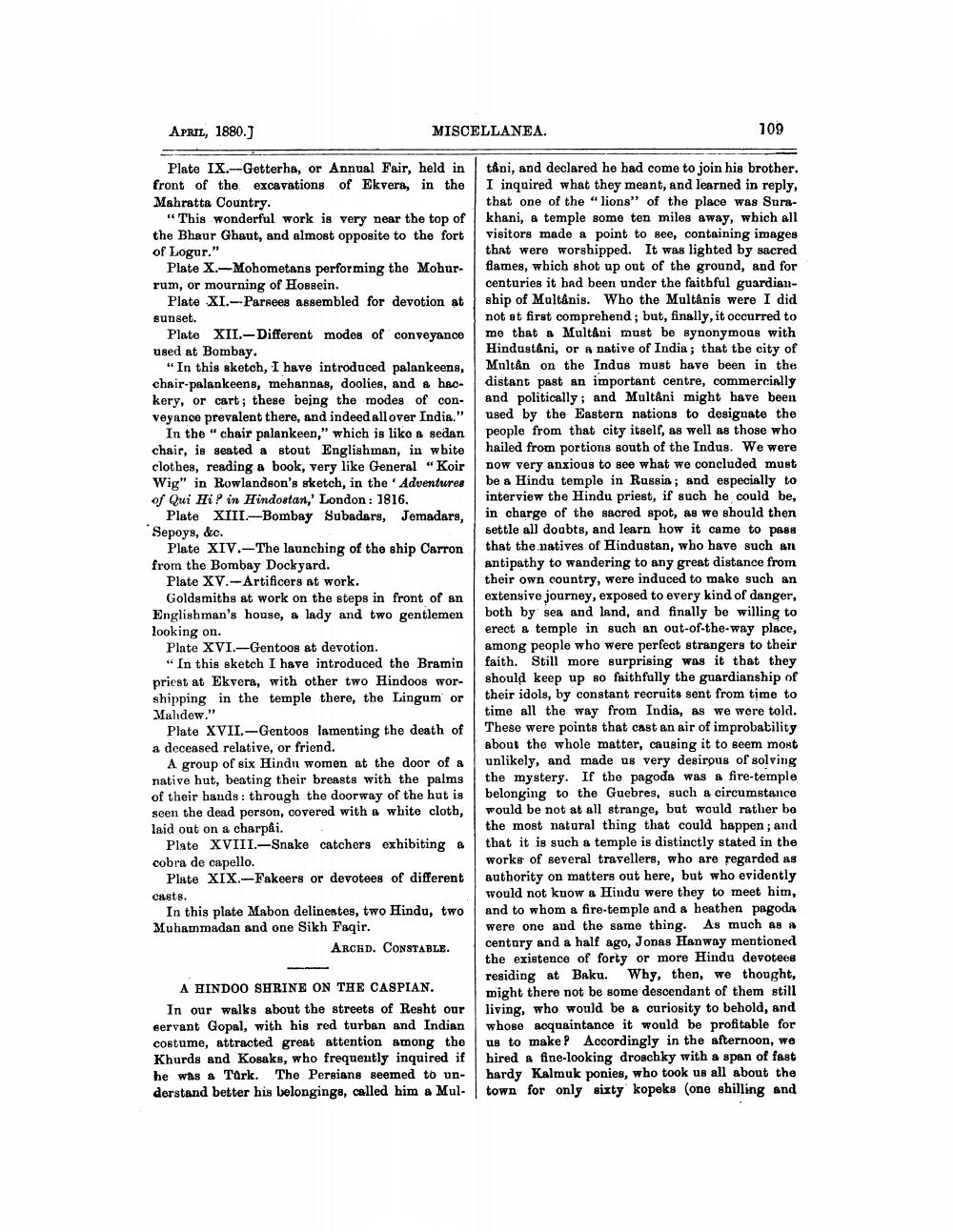________________
APRIL, 1880.J
Plate IX.-Getterha, or Annual Fair, held in front of the excavations of Ekvera, in the Mahratta Country.
"This wonderful work is very near the top of the Bhaur Ghaut, and almost opposite to the fort of Logur."
MISCELLANEA.
Plate X.-Mohometans performing the Mohurrum, or mourning of Hossein.
Plate XI.-Parsees assembled for devotion at sunset.
Plate XII.-Different modes of conveyance used at Bombay.
"In this sketch, I have introduced palankeens, chair-palankeens, mehannas, doolies, and a hackery, or cart; these being the modes of conveyance prevalent there, and indeed all over India."
In the "chair palankeen," which is like a sedan chair, is seated a stout Englishman, in white clothes, reading a book, very like General "Koir Wig" in Rowlandson's sketch, in the ' Adventures of Qui Hi? in Hindostan,' London: 1816.
Plate XIII-Bombay Subadars, Jemadars, Sepoys, &c.
Plate XIV. The launching of the ship Carron from the Bombay Dockyard.
Plate XV.-Artificers at work.
Goldsmiths at work on the steps in front of an Englishman's house, a lady and two gentlemen looking on.
Plate XVI.-Gentoos at devotion.
"In this sketch I have introduced the Bramin priest at Ekvera, with other two Hindoos worshipping in the temple there, the Lingum or Maldew."
Plate XVII.-Gentoos lamenting the death of a deceased relative, or friend.
A group of six Hindu women at the door of a native hut, beating their breasts with the palms of their hands: through the doorway of the hut is seen the dead person, covered with a white cloth, laid out on a charpai.
Plate XVIII.-Snake catchers exhibiting a cobra de capello.
Plate XIX-Fakeers or devotees of different casts.
In this plate Mabon delineates, two Hindu, two Muhammadan and one Sikh Faqir.
ARCHD. CONSTable.
A HINDOO SHRINE ON THE CASPIAN.
In our walks about the streets of Resht our eervant Gopal, with his red turban and Indian costume, attracted great attention among the Khurds and Kosaks, who frequently inquired if he was a Türk. The Persians seemed to understand better his belongings, called him a Mul
109
tâni, and declared he had come to join his brother. I inquired what they meant, and learned in reply, that one of the "lions" of the place was Surakhani, a temple some ten miles away, which all visitors made a point to see, containing images that were worshipped. It was lighted by sacred flames, which shot up out of the ground, and for centuries it had been under the faithful guardianship of Multânis. Who the Multânis were I did not at first comprehend; but, finally, it occurred to me that a Multâni must be synonymous with Hindustani, or a native of India; that the city of Multan on the Indus must have been in the distant past an important centre, commercially and politically; and Multâni might have been used by the Eastern nations to designate the people from that city itself, as well as those who hailed from portions south of the Indus. We were now very anxious to see what we concluded must be a Hindu temple in Russia; and especially to interview the Hindu priest, if such he could be, in charge of the sacred spot, as we should then settle all doubts, and learn how it came to pass that the natives of Hindustan, who have such an antipathy to wandering to any great distance from their own country, were induced to make such an extensive journey, exposed to every kind of danger, both by sea and land, and finally be willing to erect a temple in such an out-of-the-way place, among people who were perfect strangers to their faith. Still more surprising was it that they should keep up so faithfully the guardianship of their idols, by constant recruits sent from time to time all the way from India, as we were told. These were points that cast an air of improbability about the whole matter, causing it to seem most unlikely, and made us very desirous of solving the mystery. If the pagoda was a fire-temple belonging to the Guebres, such a circumstance would be not at all strange, but would rather be the most natural thing that could happen; and that it is such a temple is distinctly stated in the works of several travellers, who are regarded as authority on matters out here, but who evidently would not know a Hindu were they to meet him, and to whom a fire-temple and a heathen pagoda were one and the same thing. As much as a century and a half ago, Jonas Hanway mentioned the existence of forty or more Hindu devotees residing at Baku. Why, then, we thought, might there not be some descendant of them still living, who would be a curiosity to behold, and whose acquaintance it would be profitable for us to make? Accordingly in the afternoon, we hired a fine-looking droschky with a span of fast hardy Kalmuk ponies, who took us all about the town for only sixty kopeks (one shilling and




